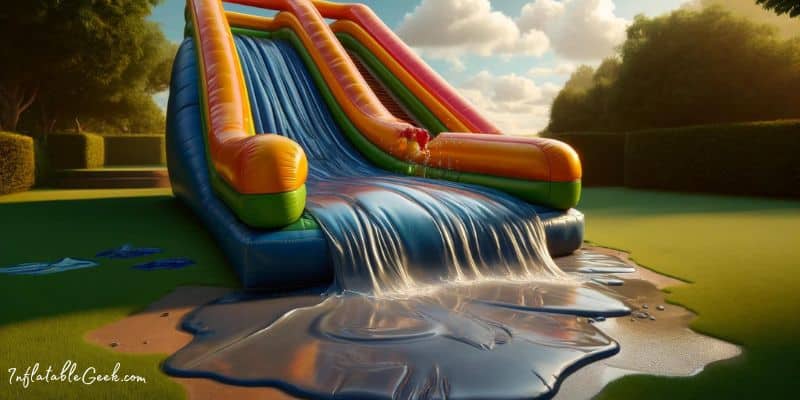Inflatable water slides are the life of any outdoor party, especially in the summer.
However, they can encounter problems that need quick fixes to keep the fun going. Here’s a firsthand account of the five most common problems with inflatable water slides and step-by-step guides to fix them.
Quick Summary Table of Problems and Solutions
Don’t you hate scrolling through a blog post trying to find what you need to know? Me, too.
So, here is a summary chart of the most important information:
(This post may have affiliate links. Please see my disclosure)
| Major Problem | Tools Needed | Time Required | Solution Approach |
|---|---|---|---|
| Leaking Air | Patch kit, vinyl adhesive, rubbing alcohol, soft cloth | 1-24 hours | Identify leak, clean area, apply patch, let cure |
| Water Pump Failure | Voltage tester, screwdrivers, pliers, replacement pump | 30 minutes – 2 hours | Check power, remove blockages, replace if necessary |
| Mold and Mildew | Mildew remover/vinegar, soft-bristled brush, hose | 2-4 hours | Clean thoroughly, rinse, dry completely |
| Tears and Punctures | Scissors, patch kit or sewing kit, waterproof sealant | 1-3 hours | Clean area, patch or sew tear, apply sealant |
| Stitching Coming Undone | Heavy-duty nylon thread, sewing needle, waterproof sealant | 1-3 hours | Sew along original stitch line, apply sealant over stitches |
Keep reading to dive into all the nitty-gritty details for the specific problem you’re facing.
Tears and Punctures

The Problem:
Sharp objects, excessive force, or general wear and tear can cause tears and punctures. These can vary in size but compromise the slide’s safety and functionality.
Fixing Steps:
- Identify the Damage: Inflate the slide to find the extent of the damage. For small punctures, the soap and water trick works well.
- Prepare the Area: Clean and dry the area around the tear. For a cleaner repair, trim any frayed edges with scissors.
- Patch or Sew: For small holes, a simple patch kit will do. Larger tears may require sewing with a durable, waterproof thread before patching.
Troubleshooting and Tips:
- Regularly inspect the slide for potential hazards that could cause damage.
- Practice proper inflation; over-inflation increases the risk of tears.
Leaking Air
The Problem:
Air leaks are one of the most common problems with inflatable water slides. A leak can be slow and unnoticeable until the structure starts losing its firmness, or it can be a significant tear that deflates the slide quickly.
Fixing Steps:
- Identify the Leak: Inflate the slide and listen for hissing sounds. For slow leaks, mix soap with water and apply it over the surface. Bubbles will form where there’s a leak.
- Patch it Up: Once you find the leak, deflate the slide. Clean the area around the leak with rubbing alcohol and let it dry. Apply an adhesive patch or use a repair kit if one came with your slide. For bigger tears, you might need to sew the tear closed before applying a patch.
- Let it Cure: Allow the adhesive to cure as per the instructions—usually 12-24 hours.
Troubleshooting and Tips:
- Patch kits specifically designed for inflatable products work best.
- For larger tears, consider using a professional repair service to ensure the structural integrity of the slide.
- Test the patch by inflating the slide and applying pressure around the repaired area.
Water Pump Failure
The Problem:
The water pump circulates water through the slide, keeping it slippery. A malfunctioning pump can lead to a dry, unsafe slide.
Fixing Steps:
- Check Power Supply: Ensure the pump is plugged in and the outlet is functional. Use a voltmeter to check for proper voltage if necessary.
- Inspect for Blockages: Debris in the pump can stop it from working. Turn off the power, remove the pump, and clear any obstructions.
- Examine the Pump: Look for signs of damage or wear. If the pump impeller is damaged or the motor has burnt out, replacing the pump is your best option.
Troubleshooting and Tips:
- Regularly clean your pump’s intake and filter to prevent blockages.
- A surge protector can prevent electrical damage to your pump.
- If replacing the pump, ensure it has the correct flow rate for your slide.
Mold and Mildew
The Problem:
Mold and mildew can form on your inflatable water slide if it’s stored while damp.
This not only looks unpleasant but can also weaken the fabric and create health hazards.
Fixing Steps:
- Clean Thoroughly: Inflate the slide and wash it with a solution of water and mild vinegar or a mildew remover designed for inflatable products. Scrub with a soft brush.
- Rinse and Dry: Rinse the slide thoroughly with water. Ensure it’s completely dry before deflating—this might take a sunny day or two.
- Store Properly: Once dry, fold and store the slide in a dry, cool place. Think about using packets that soak up moisture if it’s very humid where you live.
Troubleshooting and Tips:
- Never store the slide wet. Even a small amount of moisture can lead to mold growth.
- Inspect the slide for mold before setting it up for use. Cleaning it at the start of the season can prevent issues.
Stitching Coming Undone
The Problem:
Another one of the most common problems with inflatable water slides is when the stitching comes undone.
Frequent use and stress can cause the stitching on your inflatable water slide to tear, affecting its structural integrity and safety.
Fixing Steps:
- Assess the Damage: Carefully inspect the area where the stitching has come undone. Determine if it’s a small section that can be hand-stitched or if it requires professional repair.
- Prepare for Repair: If the area is small and you decide to fix it yourself, deflate the slide completely. Clean the area around the stitching to ensure it’s free from dirt and grime.
- Sewing the Tear: Using a heavy-duty, waterproof nylon thread, sew the open seam closed. Follow the original stitch pattern as closely as possible to maintain the slide’s strength. If you’re not comfortable sewing, consider taking it to a professional who has experience with inflatable repairs.
- Apply a Sealant: After sewing the seam, apply a waterproof sealant over the stitched area to prevent water from seeping through and causing further damage.
Troubleshooting and Tips:
- Pick a needle and thread sturdy enough to go through the slide’s fabric without making more harm.
- If the damage is extensive or located in a critical area of the slide, it’s best to seek professional repair to ensure the safety of users.
- Regular maintenance checks can help identify weak stitching before it becomes a significant problem.
Here is a video that shows you how to sew your way to a fix:
Tools & Materials You’ll Need
Having these tools and materials on hand will equip you to address most issues your inflatable water slide might face, from routine maintenance to more complex repairs.
For Patching Leaks and Tears:
- Patch Kit: Specifically designed for inflatable products. These kits usually include patches and a tube of adhesive.
- Vinyl Repair Adhesive: For securing patches on vinyl slides. Make sure it’s waterproof.
- Waterproof Tape: As a temporary fix for minor punctures or tears.
- Scissors: To cut patches to size or trim frayed edges around tears.
- Rubbing Alcohol: For cleaning surfaces around the repair area, ensuring the adhesive bonds well.
- Soft Cloth: To apply rubbing alcohol and clean the area without damaging the material.
- Sewing Kit: Heavy-duty needles and waterproof, durable thread (nylon or polyester) for stitching tears before applying patches.
For Pump Issues:
- Voltage Tester: To check electrical connections and ensure the pump is receiving power.
- Screwdrivers: Both flat-head and Phillips-head for opening the pump housing.
- Pliers: For removing any debris or blockages in the pump.
- Replacement Pump: In case the original cannot be repaired. Ensure it matches the specifications (flow rate, power) of your water slide.
For Cleaning and Preventing Mold:
- Mildew Remover or Vinegar: Choose a cleaner that’s safe for use on inflatable slides. Vinegar is a natural alternative.
- Soft-Bristled Brush: For scrubbing away mold and mildew without damaging the slide material.
- Garden Hose: For rinsing the slide after cleaning.
- Towels or a Leaf Blower: To dry the slide thoroughly after washing it.
General Maintenance:
- Air Pressure Gauge: To ensure you’re inflating the slide to the manufacturer’s recommended pressure, preventing over- or under-inflation.
- Moisture Absorbers: Handy for storage, especially in humid climates, to prevent mold and mildew.
- Storage Bag or Container: Protects the slide from pests and physical damage when not in use.
- UV Protectant Spray: To protect the slide material from sun damage and extend its lifespan.
What to Do When You Can’t Fix Your Slide?
Even with all your hard work and a complete set of tools, some issues with your inflatable water slide might be too tough to handle by yourself.
This could be due to the complexity of the issue, the need for specialized equipment, or the risk of making the problem worse.
Here’s what you can do when a DIY repair isn’t feasible:
Evaluate the Damage
First, assess the severity of the damage. Understanding the extent of the problem can help you communicate more effectively with professionals and may also impact your decision on whether to repair or replace the slide.
Consult the Manufacturer
Many inflatable water slide manufacturers offer customer support and may provide repair services or advice.
They can let you know if the warranty covers the damage, too.
If so, you might be able to get the slide repaired or replaced at a reduced cost or for free.
Seek Professional Repair Services
Search for a repair service focused on fixing inflatables.
These professionals have the tools, materials, and experience to fix complex issues that go beyond the scope of DIY repairs.
Make sure to:
- Ask for a quote before committing. Repair costs can vary widely based on the damage.
- Check reviews or ask for references to ensure you’re choosing a reputable service.
Consider Safety
If the slide is severely damaged, it may no longer be safe to use, even after repairs. In such cases, the best option might be to dispose of it responsibly and invest in a new one. Safety should always be your top priority, especially when the slide is used by children.
Recycle or Repurpose
Before disposing of your slide, consider whether parts of it can be recycled or repurposed. Some materials, like the vinyl, might be reused in different projects, reducing waste and possibly giving parts of your beloved slide a second life.
Invest in a New Slide
If repairing your slide is not cost-effective or it can’t be made safe again, purchasing a new one might be your best option.
Use this opportunity to select a slide that better suits your needs, perhaps one with enhanced features or a more durable design. Remember to apply the maintenance tips you’ve learned to extend the lifespan of your new investment.
Conclusion: Common Problems With Inflatable Water Slides
By following these tips and tricks from firsthand experience, I hope you save a lot of time and trouble.
Thanks for reading!
Read More:

